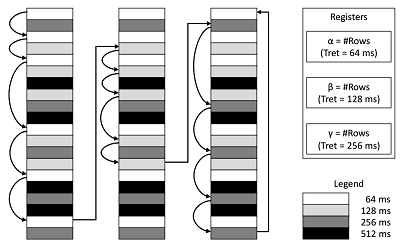CLARA: Circular Linked-List Auto- and Self-Refresh Architecture

With increasing DRAM densities, the performance and energy overheads of refresh operations are increasingly significant. When the system is active, refresh commands render DRAM banks unavailable for increasing periods of time. These refresh operations can interfere with regular memory operations and hurt performance. In addition, when the system is idle, DRAM self-refresh is the dominant source of energy consumption, and it directly impacts battery life and standby time. Prior refresh reduction techniques seek to reduce active-mode auto-refresh energy, reduce self-refresh energy, improve performance, or some combination thereof. In this paper, we present CLARA, a circular linked-list based refresh architecture which meets all three goals with very low overheads and without sacrificing DRAM capacity. This approach exploits the variation in retention time at a chip granularity as opposed to a DIMM-wide, rank granularity in prior work. CLARA reduces auto- and self-refresh by 86.2%, independent of workload. Auto refresh reduction improves average CPU performance by 3.1% and 6.5% in the normal and extended temperature range, respectively. GPU performance improves by 2.1% on average in the extended temperature range. DRAM idle power during self-refresh is reduced by 44%. The area overhead of CLARA in the DRAM is about 0.085% and negligible in the memory controller.
Publication Date
Research Area
External Links
Uploaded Files
Copyright
Copyright by the Association for Computing Machinery, Inc. Permission to make digital or hard copies of part or all of this work for personal or classroom use is granted without fee provided that copies are not made or distributed for profit or commercial advantage and that copies bear this notice and the full citation on the first page. Copyrights for components of this work owned by others than ACM must be honored. Abstracting with credit is permitted. To copy otherwise, to republish, to post on servers, or to redistribute to lists, requires prior specific permission and/or a fee. Request permissions from Publications Dept, ACM Inc., fax +1 (212) 869-0481, or permissions@acm.org. The definitive version of this paper can be found at ACM's Digital Library http://www.acm.org/dl/.
